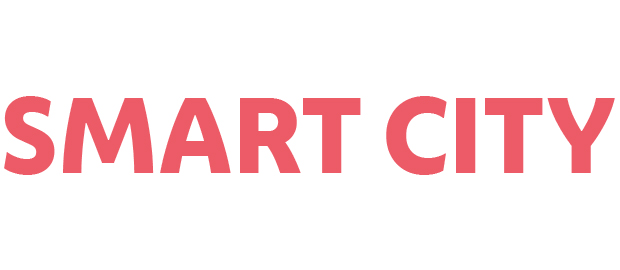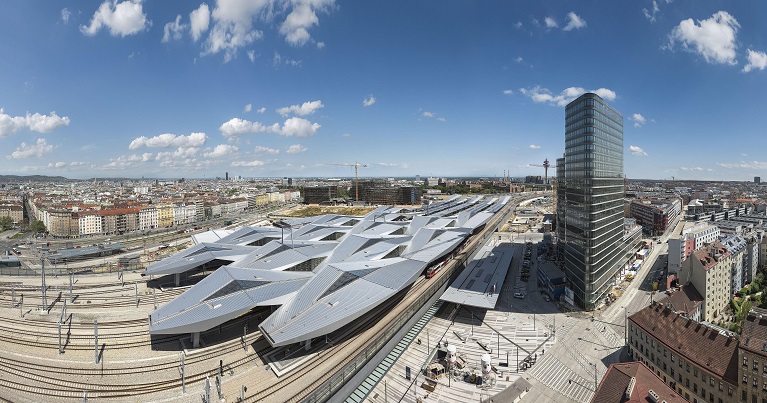Apart from the new central station, which significantly facilitates transport to and through Vienna, an entirely new district, with housing, office buildings and various leisure offers, was created around the new station.
The Vienna Central Station project spanning over 109 hectares is one of the most important infrastructure projects of the past few years. Just a 2.5 kilometre stone’s throw from Stephansplatz a new district was created, which is characterised by the best possible transport connections and a high quality of life, with the new Vienna Central Station at its core.
With the central station, the inner-city public transportation systems and the connection to Vienna Airport, no other point of departure in Vienna offers such quick and easy access to destinations throughout Austria, Europe and the world.
The new district offers modern mobility whilst at the same time offering living spaces in a central location, with full city infrastructure and a little piece of nature outside the front door.
Optimal regional, national and international connections
The new centralstation is being constructed as a through station with twelve tracks and ten platforms. For the first time, trains will arrive in the regional state capital from all directions and in turn connect in all directions. By creating a high-performance north-south and east-west link, the station will become the most important hub for regional, national, and international travel and a central junction in the trans-European rail network.
This means faster train connections, more comfort when travelling because changing trains is simple and connections are optimised, as well as accessibility in line with the latest standards. The new station brings the cities of Europe closer together and makes borders disappear. The route from Salzburg to Budapest directly via Vienna’s Central Station will be in five hours instead of the current time of approximately six hours. Speedy, direct connections will also be available for local and regional transportation. From Eisenstadt to St. Pölten or from Wiener Neustadt to Bratislava – without having to change.
Station building
The new central station will be constructed on the site between the former south and east stations and Südtiroler Platz. The design of the new station, with its main entrance on Südtiroler Platz, will be bright and easily accessible. Escalators and elevators convey travellers to the station‘s ten platforms. Over 20,000 square feet of floor space, around 100 shops and numerous restaurants invite visitors to relax, browse and dine. An underground parking garage with spaces for more than 600 cars is being constructed as well as three bicycle garages with around 1,100 spaces.
The eye-catching visual feature of the new station is the folded, diamond shaped roof, which extends over the platforms. This translucent roof of around 25,000 square metres in size ensures a bright and friendly atmosphere. Clear guidance systems help travellers to find their way. Intensive work has already been carried out on the station accessibility concept to ensure that the traffic situation is designed in an accessible manner and is in accordance with the current state of the art.
New districts around the train station
Around the station, an entirely new urban district is gradually emerging on the 59-hectare former ÖBB site. Altogether, approximately 5,000 apartments are being built to accommodate 13,000 residents, offices for 20,000 employees and space for hotels, shops, services and catering establishments. The city development area is located between the Wiedner Gürtel to the north, Arsenalstrasse to the east as well as Sonnwendgasse and Gudrunstrasse to the south and west.
The area south of the site in the so-called Sonnwendviertel, is designated primarily for an attractive residential district around the 7-hectare Helmut Zilk park. On the corner of Wiedner Gürtel and Arsenalstrasse the new home of the Erste Campus arises, the new headquarters of Erste Group Bank AG. Immediately south, a real estate developer is constructing an office/residential complex. The southern forecourt of the train station is designated for the ÖBB Group headquarters. An education campus and youth club were opened in the fall of 2014.
In 2012, a new model in urban land use, created through a collaborative process, was designated for the 11-hectare northeast section of the municipal development area. The goal: to optimise the urban development landscape and to place greater focus on small-scale structures. Plans call for the creation of a vibrant, liveable district for 3,500 residents, featuring homes, offices, retail, caterers, local supplies and amenities, as well as counselling and social services facilities, by 2016. Largely free of through-traffic, the area will host an abundant array of open spaces with high quality recreation.
Sustainable planning, construction and operation
The planners of Vienna Central Station have already put a premium on the diligent and sustainable handling of the environment: Overall, three environmental impact assessments have been performed. The effects on a wide range of areas such as the burden on noise and climate pollution, ground water, air pollutants and other pollutants were investigated and assessed. An impressive example of the protective measures laid down: around 14,000 soundproof windows and eight kilometres of noise barriers.
In the construction of the central station is also on respected for an eco-friendly construction sites: all the recyclable material – especially concrete demolition and ballast – was prepared on the premises and reinstated. Excavation that could no longer be used on the construction site, was transported by rail. This created a private loading track. To meet the enormous demand for concrete, an own construction site concrete mixing plant produced up to 180 cubic meters of concrete per hour. All these measures meant a decisive minimising of the transport of the and on the ground.
Equal priority was given to the use of sustainable materials and to achieving the greatest possible energy efficiency. Geothermal energy, solar energy, district heating and cooling networks, an integrated CO2-modulated ventilation system and grey water utilisation: together, these resources make Vienna Central Station a model project of energy-efficiency, in which resource use is minimised and the environment protected.
Contact
Michael Braun
E-Mail: michael.braun@oebb.at
Website: www.wien.gv.at/verkehr-stadtentwicklung/hauptbahnhof or www.hauptbahnhof-wien.at
This post is also available in: German




